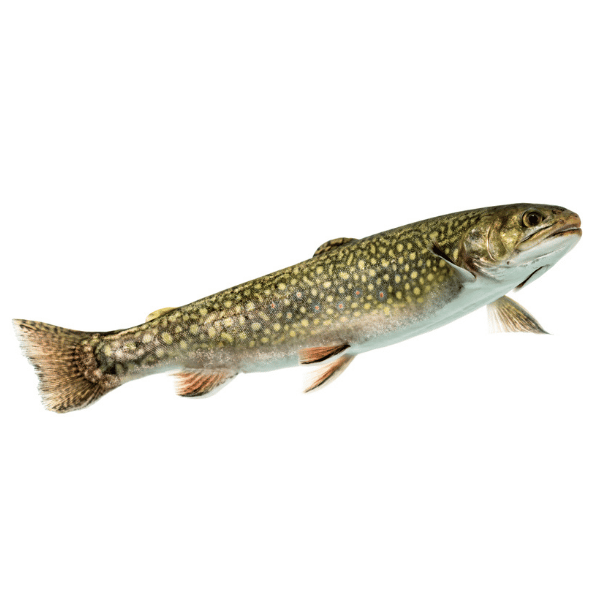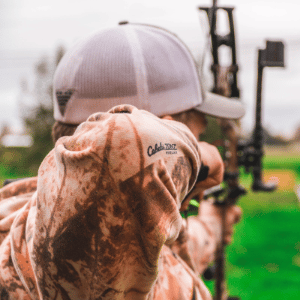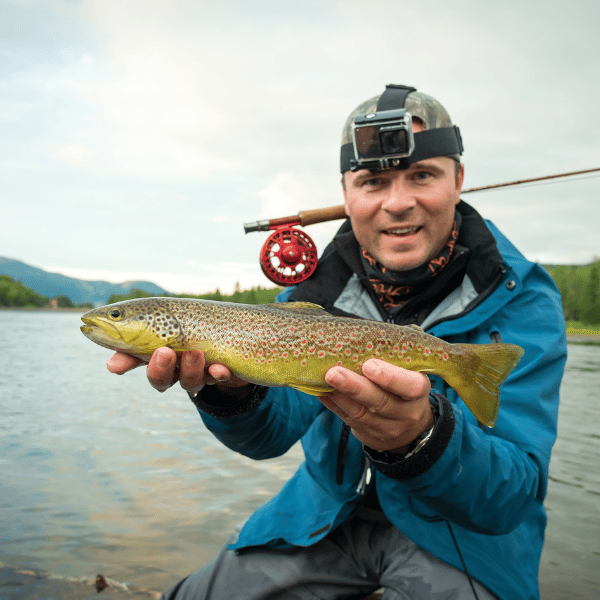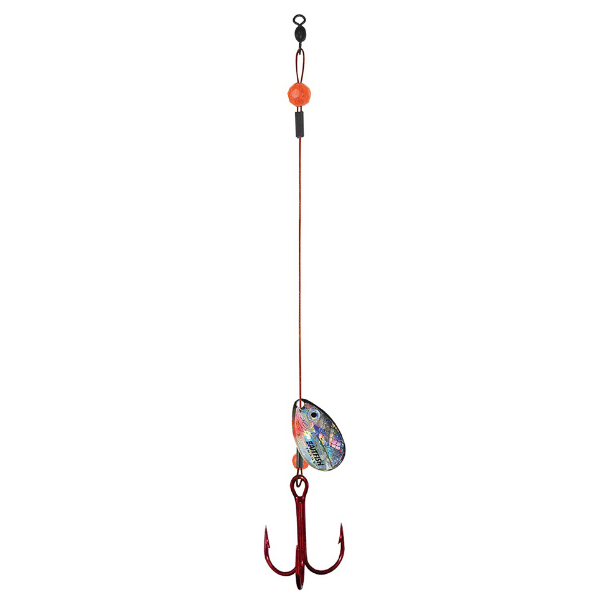How to Tie a Double Nymph Rig (Step by Step)
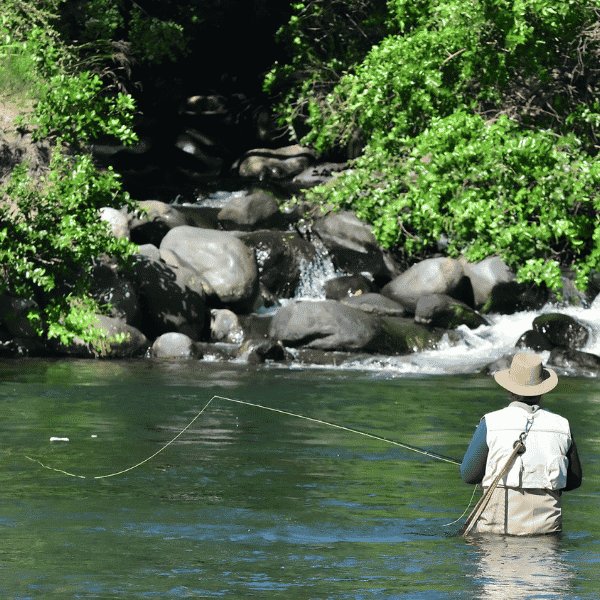
You may be an inexperienced fly-fisher wondering, how do I make a double nymph rig?
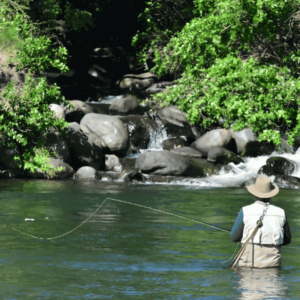
Experts and beginners alike can learn from this comprehensive guide that explains what a double nymph is and how to set up a nymph rig in an easy-to-understand format.
Developing the right weight and length of your rig will depend on personal preference and the conditions in which you are fishing. The double nymph rig has a standard loop-to-loop connector that will connect to the end of your line and sink your dropper to the optimal feeding range.
Constructing a rig can be difficult to understand as a beginner, so keep reading to learn more about what a double nymph rig system is and how to tie a double nymph rig step by step.
Contents
What is a Double Nymph Rig?
Many beginners may not know how to cast a complicated rig such as the double nymph rig. If you are a novice fly-fisherman, it is time you learned what a double nymph rig is all about.
A double nymph rig is a fly-fishing system that employs a tapered line that attaches an indicator and a dropper to sink below the surface level and put your bait in the proper feeding range for big fish game. Trout often reside deep under the surface, so you want to be able to present your bait to the fish in a way that will be most pleasing.
Finding the right color indicator and droppers that match the nymphs and bugs that sink well below the surface to be consumed by big game fish will help you present your bait to unsuspecting victims.
You want a rig that is tapered well so the line is easily concealed, and the lures sink to the optimal feeding level as soon as possible. Keep reading to learn about the circumstances that may lead you to experiment with double nymph rig fishing.
When to Use a Double Nymph Rig
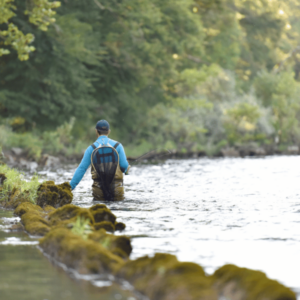
When you are using two separate indicators at once to lure potential big fish game, you are essentially combining dry fishing with dropper fishing. While this setup may be complicated, this design is favorable in some fishing conditions.
Using a double nymph rig will be helpful when fishing in streams, especially when dealing with mountain runoff. Double nymph fishing is a great way to reach down into the depths into areas that are less chaotic, a commonplace for trout to wait for insects or nymphs to straggle along so that they can reach up and grab them without having to fight the tough current.
You want your lure to float gracefully, and you want to use a tapered line as to not sound any alarms and scare away prospective prey. A double nymph rig is optimal for achieving the right amount of depth needed to sink into calmer flowing water so that it is easily recognizable to the prospective fish that you are aiming to catch.
If your double nymph rig is properly constructed, you may be able to feed a fishing frenzy and reap massive gains. Read on to learn how to tie a double nymph rig, step-by-step.
How to Tie a Double Nymph Rig
Even the most accomplished double nymph masters will tell you that developing your rig is essential in catching the right game. The specific dimensions of your line will depend on personal preference and geographical accuracy. Keep reading as we break down how to set up a double nymph rig in an easy-to-understand, step by step fashion.
Tie the Desired Leader to Your Prospective Fly Line
Most new fly lines have a small loop at the forward end of the design. First, you must attach your reel and feed your line through every guide on your rod. You must be diligent because missing a guide is easy to do. Connect your leader to your fly line. We suggest using a tapered, knotless leader for most fishing situations. If you are fishing for big game such as trout, you may want to use a heavier leader, such as the 7-foot 3x or 4x leader.
Connect the First Section of the Tippet to Leader
Adding a tippet to your leader will help present your fly to the fish that you are trying to catch in a way that is natural and familiar. Strings are visible to fish, especially big fish that have a lot of experience in the waters in which you are fishing. Connect a 4x or 5x tippet to your tapered line and attach the flies to the tippets. Connect the leader to the tippet with a double surgeon’s knot for ensured protection against unwanted snags. Remember, poorly trimmed knots will be very visible to experienced fish.
Add Fly Number 1
The first fly should be the heavier of the two used, and we suggest using sizes 14 and 18. You will want to place the lighter gauge lure, 18, on the lower end of your rig. There are many ways to attach flies to the tippets, and the most used knot is the Clinch Knot. Alternatively, if you are looking for strength, consider using the “improved Clinch Knot.” A beginner may be more apt to using a Ty-Rite tool that makes tying a fly to a section of tippet easy for novice fly-fishermen.
Connect the Second Section of Tippet
Tie the second tippet section to the hook bend of the first nymph with a Clinch Knot to ensure the proper length for the optimal depth region you are shooting for. The length will depend on circumstance and preference, but a good rule of thumb is to keep the second section of the tippet similar to the length used for the first tippet. Overall, you want the depth of your rig to reach 1 to 1 ½ the depth of the water in which you are fishing.
Attach the Second Fly
If you have made it this far, you have reached one of the easiest parts of the nymph rigging process. Just as you attached your upper fly, tie the second nymph to the end of the second section of your tippet and trim the knot. Pinch the leader and tippet connection between your thumb and forefinger while being careful not to crush the hackle, give it a tight tug, and set your lure up for success.
Add Weights
This may be the most essential part of the rigging process, as this will help your indicator and dropper reach the optimal feeding zone in the least amount of time possible. The best place to add weight is right above the leader to the first tippet junction and use the knot as a barrier. This will provide a consistent casting motion for your double nymph rig. You do not want to make your line too heavy, as it will be prone to more snags and disruptions from harmful debris.
Attach Strike Indicator if Needed
If you are a beginner, it may be beneficial to know exactly when fish strike your lure and how much they might be pulling right off the bat. A strike indicator is a glorified buoy that alerts you when a fish may be tugging on your indicator or dripper. There are many attach strike indicator designs available, and you may use different models for faster-moving, deeper, or slower-moving water conditions.
How to Cast a Double Nymph Rig
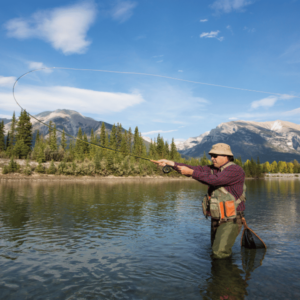
Casting a double nymph rig for the first time can come with some challenges, as this system requires skill, patience, and dedication to master. Even if you have the secret to great casting, a fly-fisher must be able to manipulate their rig with ease to suit even the most dramatic water conditions. If you are curious about how to cast a double nymph rig, we will break it down for you below.
The first tip is to stay alert and monitor your rig’s success with every cast. If your line keeps snagging and breaking off, you may want to consider casting in a deeper region than the one you are lurking with. If you have spent hours skimming the top of the water, you may not run into any exceptional fish game. Monitoring the success and performance of each cast time and time again as you perfect the dimensions of your rig is essential for peak performance.
The second tip we have for you is to master the element of patience. If you rush a casting stroke, you may not be waiting for the flies to come around at the end of your stroke and reach the optimal feeding depth for the best game. Take your time with each cast and listen to your rig, because the only indicator for success and mastery is time and practice.
For more information on casting, check out our Beginner Guide to Fly Fishing Techniques.
